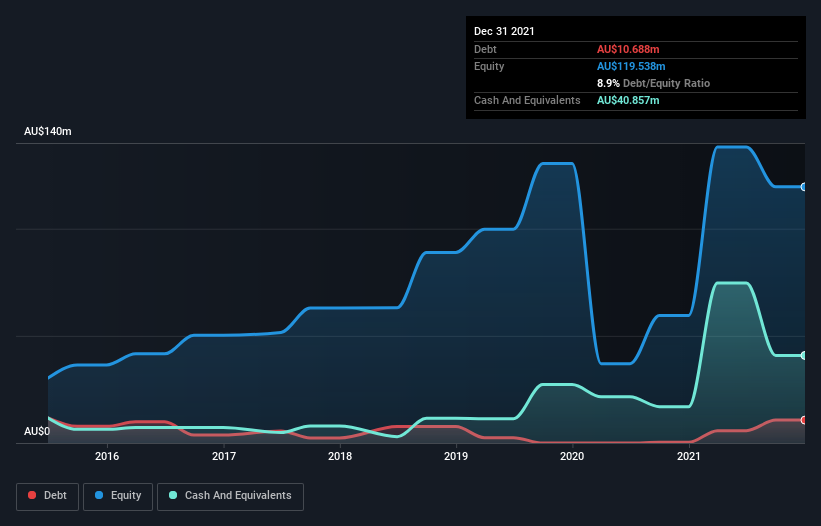The external fund manager backed by Berkshire Hathaway's Charlie Munger, Li Lu, makes no bones about it when he says 'The biggest investment risk is not the volatility of prices, but whether you will suffer a permanent loss of capital.' It's only natural to consider a company's balance sheet when you examine how risky it is, since debt is often involved when a business collapses. As with many other companies Strike Energy Limited (ASX:STX) makes use of debt. But is this debt a concern to shareholders?
When Is Debt Dangerous?
Debt and other liabilities become risky for a business when it cannot easily fulfill those obligations, either with free cash flow or by raising capital at an attractive price. Ultimately, if the company can't fulfill its legal obligations to repay debt, shareholders could walk away with nothing. While that is not too common, we often do see indebted companies permanently diluting shareholders because lenders force them to raise capital at a distressed price. Of course, plenty of companies use debt to fund growth, without any negative consequences. The first thing to do when considering how much debt a business uses is to look at its cash and debt together.
View our latest analysis for Strike Energy
What Is Strike Energy's Net Debt?
You can click the graphic below for the historical numbers, but it shows that as of December 2021 Strike Energy had AU$10.7m of debt, an increase on AU$322.0k, over one year. However, its balance sheet shows it holds AU$40.9m in cash, so it actually has AU$30.2m net cash.

How Strong Is Strike Energy's Balance Sheet?
Zooming in on the latest balance sheet data, we can see that Strike Energy had liabilities of AU$18.4m due within 12 months and liabilities of AU$17.7m due beyond that. On the other hand, it had cash of AU$40.9m and AU$1.66m worth of receivables due within a year. So it can boast AU$6.37m more liquid assets than total liabilities.
Having regard to Strike Energy's size, it seems that its liquid assets are well balanced with its total liabilities. So it's very unlikely that the AU$549.5m company is short on cash, but still worth keeping an eye on the balance sheet. Simply put, the fact that Strike Energy has more cash than debt is arguably a good indication that it can manage its debt safely. When analysing debt levels, the balance sheet is the obvious place to start. But ultimately the future profitability of the business will decide if Strike Energy can strengthen its balance sheet over time. So if you want to see what the professionals think, you might find this free report on analyst profit forecasts to be interesting.
Given its lack of meaningful operating revenue, Strike Energy shareholders no doubt hope it can fund itself until it can sell some combustibles.
So How Risky Is Strike Energy?
Statistically speaking companies that lose money are riskier than those that make money. And in the last year Strike Energy had an earnings before interest and tax (EBIT) loss, truth be told. Indeed, in that time it burnt through AU$41m of cash and made a loss of AU$16m. However, it has net cash of AU$30.2m, so it has a bit of time before it will need more capital. Overall, its balance sheet doesn't seem overly risky, at the moment, but we're always cautious until we see the positive free cash flow. There's no doubt that we learn most about debt from the balance sheet. However, not all investment risk resides within the balance sheet - far from it. For example, we've discovered 4 warning signs for Strike Energy (2 are a bit unpleasant!) that you should be aware of before investing here.
If you're interested in investing in businesses that can grow profits without the burden of debt, then check out this free list of growing businesses that have net cash on the balance sheet.
New: Manage All Your Stock Portfolios in One Place
We've created the ultimate portfolio companion for stock investors, and it's free.
• Connect an unlimited number of Portfolios and see your total in one currency
• Be alerted to new Warning Signs or Risks via email or mobile
• Track the Fair Value of your stocks
Have feedback on this article? Concerned about the content? Get in touch with us directly. Alternatively, email editorial-team (at) simplywallst.com.
This article by Simply Wall St is general in nature. We provide commentary based on historical data and analyst forecasts only using an unbiased methodology and our articles are not intended to be financial advice. It does not constitute a recommendation to buy or sell any stock, and does not take account of your objectives, or your financial situation. We aim to bring you long-term focused analysis driven by fundamental data. Note that our analysis may not factor in the latest price-sensitive company announcements or qualitative material. Simply Wall St has no position in any stocks mentioned.
About ASX:STX
Strike Energy
An independent gas producer, explores for and develops oil and gas resources in Australia.
Good value with adequate balance sheet.
Similar Companies
Market Insights
Community Narratives



